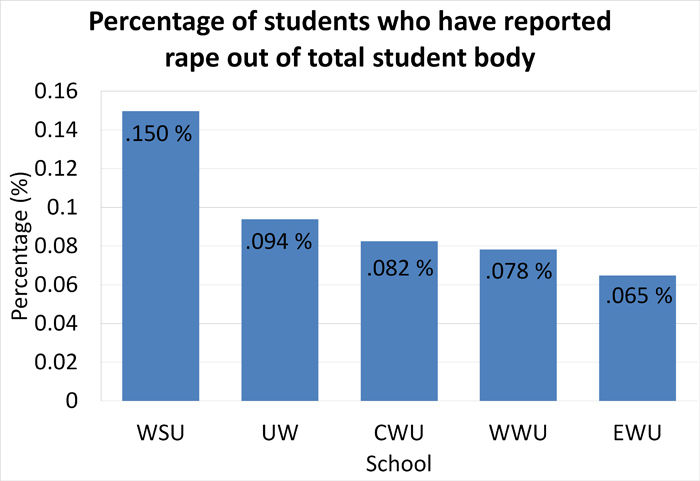Sexual assault statewide
April 22, 2016
A 2016 safety report indicates WSU has the highest rate of reported rapes per student across the five major public universities in Washington, though administrators argue the numbers indicate improvements in reporting.
Melynda Huskey, Interim Vice president of student affairs and dean of students at WSU, said the statistics differ between universities because they are based on the level of reporting at each university, not the actual level of rape.
“It is likely that 20 percent of our female students are likely to experience some form of unwanted sexual contact during their four years here,” Huskey said citing a 2015 National Sexual Violence Resource Center statistic. “Until we see that number of reports, we’re not approaching were we need to be, but the fact that we have more, that we are a little closer to that number than other institutions, gives me some hope that what we’re doing is actually helping.”
The 2016 report is based on uniform requirements from the Clery Act, a congressional action which requires all public universities to submit reported crimes in a standard format, for the purpose of providing timely warnings for students and employees when incidents have occurred.
From 2012 to 2014, WSU reported 22 on-campus rapes and eight off-campus rapes, in the same time period, the University of Washington reported 14 on-campus and 28 off-campus rapes, Western Washington University reported 11 on-campus and one off-campus rape, Central Washington University reported nine on-campus and zero off-campus rapes, and Eastern Washington University reported seven on-campus rapes and one off-campus rape.
The raw number of reports would indicate that UW has a higher number of sexual assaults total, but according to the UW and WSU websites, UW has 44,786 students enrolled at its Seattle campus, while WSU has 20,043 enrolled at the Pullman campus.
UW has more than twice the number of students, but it does not have twice the number of sexual assault reports.
Laurie Connelly, Title IX Coordinator at Eastern Washington University, said she believes the number of sexual assaults in the Clery Report is only part of the picture.
The Department of Education reporting standards and the language of the Clery Act only cover sexual assaults which happen on-campus or the immediate adjacent area, which influences what goes into the report.
At universities where housing is farther away, there may be more sexual assaults happening but they may not be included in the report, Connelly said.
“Our perspective is we’re trying to do more things to make sure they get reported,” Connelly said. “Not just so we can take action, but so we can support survivors.”
The American College Health Association National College Health Assessment has found 9 percent of college females and 2.9 percent of college males reported sexual touching without their consent in the last year.
The survey also concluded that only 13 percent of females reported feeling very safe in their community around their school at night and 30 percent of men.
Huskey said the university culture of WSU could be a factor in the difference of sexual assault rates between universities, but it is difficult to know for sure.
“I don’t think it helps that alcohol is involved in many social events in a way that seems to be connected with a lot of poor decision making, but at the same time, many, many people drink and do not commit sexual assault,” Huskey said. “There’s a decision making process for the person that commits the assault that alcohol does not excuse. If you commit a sexual assault, incapacity can’t be argued.”
Huskey said the university may not be impacting prevalence yet, but she hopes that they have created an environment that students can come forward safely and be treated with respect.
All data was gathered from the Annual Security/Fire Safety Report available on all university police websites. Title IX coordinators at Western Washington University, University of Washington and Central Washington University could not be reached for comment.






















